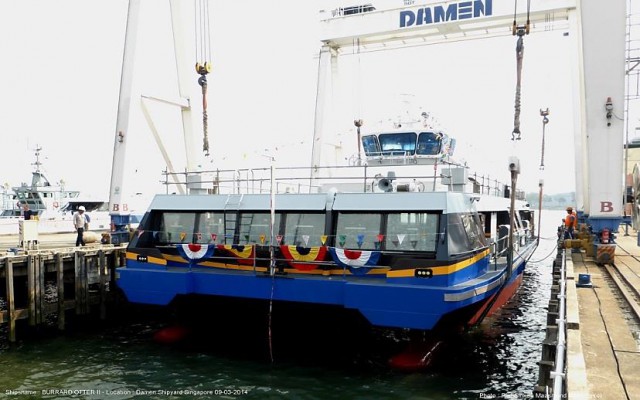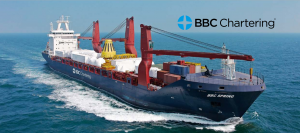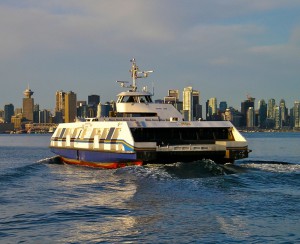Introducing TransLink’s new SeaBus: the Burrard Otter II!
Introducing TransLink’s new SeaBus: the Burrard Otter II!

Introducing: Burrard Otter II, our new SeaBus, which is scheduled to go into service this fall.
The Burrard Otter II is the first SeaBus to be built to a Classification Society Standard (Lloyd’s Register), and it was designed by noted Vancouver, BC-based Naval Architectural firm Robert Allan Ltd.
The vessel has just completed sea trials in Singapore, and soon will be prepared for shipment to Vancouver.

How will it get here?
The Burrard Otter II will be loaded onto a heavylift carrier similar to this one.
The cargo ship will make a few stops at other ports before delivering the new SeaBus to the Port of Metro Vancouver by late July.
What’s next?
Once it arrives, the Burrard Otter II will go through more sea trials to make sure it’s running properly after such a long journey.
SeaBus employees then will be trained on operations and maintenance of the new vessel.
Following an inspection by Transport Canada, the Burrard Otter II will go into regular service, currently scheduled for fall.

What about the other SeaBuses?
The Burrard Otter II will share duties with the Burrard Pacific Breeze, which made its maiden voyage on December 23, 2009.
The original Burrard Otter will be retired from active service, and the Burrard Beaver will be retrofitted ($1 million) and used as a spare vessel.
How much did the Burrard Otter II cost?
The Burrard Otter II will cost just over $22 million. This includes the cost of design and construction, as well as import duties.
Ninety percent of the cost or about $20 million was funded through a Federal government contribution (Gas Tax), and TransLink funded the remaining 10% (or about $2 million).
Burrard Otter II by the numbers
Passenger capacity: 395 + 4 crew
Size:
- Length: 34.29 m (112’ 6”)
- Width: 12.65 m (41’ 6”)
- Depth: 3.57 m (11’ 8”)
- Tonnage: Lightship weight is 164 tonnes (net), 453 (gross)
Engine:
- Type of engine: 4 x MTU/Detroit Diesel Series 60
- Horsepower (300 kilowatts each x 4): 400 hp x 4 = 1600 hp
SeaBus Fast Facts
- Average daily ridership (2013): 16,600
- Total boarded passengers in 2013: 6,044,955.
- Operating cost (2013): $10.3 million
- Sailings/Crossings a year (2013): 43,920
- SeaBus officially went into service : June 17, 1977.
- Distance per trip: 3.24 km (1.75 naut. mi.)
Author: Jennifer Siddon






How great was the cost differential between building this locally versus overseas?
A billion dollars.
What is the height above the floor of the bottom of the front/rear windows?
Are the seats uncomfortable and made out of cloth that stains easily?
Judging from the name at least, it sounds like you made some better decisions this time.
Hi David and ‘mike0123’, I’ve got the answers to your questions!
Cost differential: the difference in price to the taxpayer is about $5 million. But just as importantly, the company building our SeaBus builds a lot of ships—over 130 vessels last year. They own quite a few shipyards—the shipyard building our SeaBus builds about 10 aluminium vessels a year. By comparison, the local company that proposed to build our SeaBus has only built a few vessels over the last two decades.
The windows are at the minimum height that we can legally install them, below the shoulders of people sitting down, about a foot below the windows on the Burrard Pacific Breeze. They are fantastic, and our passengers will love the view and the feeling of openness in the new passenger compartment.
While everybody has a different opinion about the comfort of a particular type of seat, this time we have used proper bus-industry seats (USSC CitiPro), rather than trying to make something from the marine industry work for our purposes. The seats are covered in the standard shiny-textured waterproof vinyl that you’ve seen in our newer buses, so they are easily cleaned, and you can see if anything’s been spilled on them. Another advantage of the new seating is that we were able to install flip-up seats in the front and rear corners of the vessel. Flip-up seats are normally used on our buses to make space for wheelchairs and mobility-assist devices. On the new SeaBus, there is ample space for scooters and wheelchairs, so the flip-up seats make extra space that can be used for bicycle storage!
Thanks Allen. It’s great to hear that the windows will be lower. The vinyl seats in newer buses are good enough and much better than the cloth seats in the last seabus.
So you still be running only 2 seabuses? It is 2014, when will you get with the times and run all three. People need to get around quicker. This every 15 minute sailing causes delays. Passengers have to literally stand around (wasting their precious time) waiting for the next seabus. And of course if the seabus is not in sync with your transfer to a bus, then again, passengers waste another 15 minutes just standing around waiting. Keep in moving, go, go, go.
Hi Allen. An 2005 article in The Province mentioned that TransLink had initially identified 24 potential ferry terminals for expansion. A pilot project was planned to run from Snug Cove to Ambleside, then onto Waterfront.
The trial never came to fruition so one might say the plan is “dead in the water”.
Is that still the case even if all four ferries were kept? Could someone potentially purchase the retired ferry and run it elsewhere?
Article link: http://www.canada.com/vancouver/features/transportation/story.html?id=ac844cad-caaa-4db5-86f5-a9f7f4d26286
Angie – the SeaBus schedule and 15 min sailing time is restricted by the marine traffic in Burrard Inlet. Seabus is not permitted to go any faster
The seabuses are mostly used during peak times and parked the rest of the day idled. To me, it is Wasteful. I remember Vancouver was planning a tunnel under Burard Inlet but didn’t mention tolling the project. Perhaps tolling was a bad word then which erased the proposal. Now the Burard Otter II is problematic because of air conditioning issues. Design fault perhaps or cheap equipment ?
Like the design faults on the Port Mann Bridge project and the unjust tolling fees on the backs of a smaller percentage of residents living across the Fraser River but work in Vancouver while others uses the non toll roads. Too much bureaucracy forces too much taxation on innocent taxpayers. No tolls is equality for all.